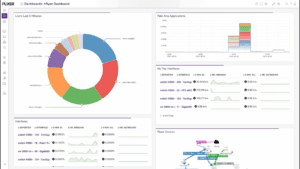Network infrastructure generates a constant stream of IP traffic, and understanding how that traffic moves is essential for maintaining performance, availability, and security. NetFlow is a protocol designed to capture metadata about these traffic flows, offering a structured way to monitor activity across routers, switches, and other Layer 3 devices.
This blog explores how NetFlow works, the components involved in its deployment, and the types of insights it enables. Whether used for troubleshooting, long-term planning, or security analysis, NetFlow provides a detailed view into the behavior of data on the network.
How NetFlow Works
NetFlow is a network protocol designed to collect and export metadata about IP traffic traversing a network device, such as a router or switch. It operates by categorizing packets into flows, which are defined by a unique combination of attributes known as the 5-tuple: source/destination IP addresses, source/destination ports, and protocol.
When a packet enters a NetFlow-enabled device, it is matched against existing flows in the flow cache. If no match is found, a new flow record is created. Flow records are periodically exported to a NetFlow collector based on active (e.g., 30 minutes) or inactive (e.g., 15 seconds) timeouts.
The protocol’s one-way nature means that bidirectional communication (e.g., a client-server interaction) generates two distinct flows. Solutions like Plixer One can then analyze this granular data to visualize traffic patterns, identify bandwidth hogs, and detect anomalies.
Timeouts in NetFlow
There are two types of timeouts: inactive and active. Inactive timeouts close a flow after a brief period of silence—typically 15 seconds—to conserve memory, while active timeouts force export after a longer interval (usually 30 minutes) to avoid long-running flows becoming stale. The result is a dynamic, high-resolution view of traffic behavior across your network.
Defining a “Flow”
NetFlow defines a “flow” as a unidirectional sequence of packets that share identical attributes across the 5-tuple. This means that a conversation between a client and a server results in two separate flows: one for each direction.
Each flow record can include additional metadata beyond the basics.
- Type of Service (ToS) fields indicate traffic prioritization
- Packet and byte counts measure traffic volume
- Timestamps record the duration of the flow for latency and performance analysis.
Components of a NetFlow Deployment
A successful NetFlow deployment relies on three primary components: the exporter, the collector, and the analyzer.
The exporter, usually a router or Layer 3 switch, is responsible for aggregating packets into flows and sending those flow records to a centralized location. Exporters distinguish between flows using the 5-tuple and apply timeouts to manage cache efficiency.
The collector acts as a repository, receiving and storing flow data from exporters. A good collector not only retains raw flow records but also pre-processes them, removing noise, aggregating similar flows, and preparing data for analysis. Collectors must also support multiple NetFlow versions, including the commonly used v5 and the more flexible v9.
Finally, the analyzer translates flow records into actionable intelligence. These platforms correlate flow data with contextual metadata like user identities or application types, helping teams identify trends, investigate incidents, and optimize performance. Without a capable analyzer, NetFlow is little more than raw data.
Benefits of Monitoring NetFlow
Security Threat Detection
While organizations have long used NetFlow for traffic analysis and bandwidth optimization, its role in network security has grown over time.
For starters, NetFlow enables anomaly detection. Suspicious behavior—such as a workstation communicating with known malicious IP addresses or a sudden spike in traffic to an unusual destination—can be quickly flagged. Because NetFlow records every conversation on the network, it’s great for identifying threats like port scans, DDoS attacks, or data exfiltration attempts.
Flow data is also valuable for forensic analysis. During or after a security incident, NetFlow records can help reconstruct an attack timeline. Metadata fields such as source MAC address, interface ID, and timestamps provide crucial context in tracing where a threat originated and how it moved through the network.
Furthermore, the protocol supports compliance reporting. Whether your organization needs to align with GDPR, HIPAA, or another regulation, NetFlow data provides auditable logs of network activity that demonstrate due diligence.
Troubleshooting and Performance Optimization
In day-to-day operations, one of the most practical uses of NetFlow is identifying and resolving performance issues. By analyzing flow data, IT teams can pinpoint which applications or users are consuming the most bandwidth.
For example, let’s say a particular WAN link is consistently operating at or above 80% utilization. Flow data can reveal whether that usage is due to business-critical applications, or simply employees streaming video during peak hours.
NetFlow also highlights bottlenecks by correlating flow volumes with device interface statistics. For instance, if a WAN interface is hitting 95% capacity, the top talkers and top applications derived from flow data can show whether the issue is temporary or systemic.
Capacity Planning
Historical flow data provides the foundation for capacity planning. Long-term trends can indicate when you need to upgrade infrastructure.
For example, a university network might see predictable traffic surges during enrollment periods. They could use six months of flow records to justify upgrading a 1Gbps link to 10Gbps.
NetFlow also supports application and user identification. With the integration of technologies like NBAR2, organizations can classify traffic from applications like Zoom, Microsoft Teams, or Salesforce. This allows for fine-grained policy enforcement and ensures that business-critical applications receive the bandwidth and priority they need.
Storing, Visualizing, and Managing NetFlow Data
Once collected, NetFlow records are typically stored in high-performance databases such as SQL or Elasticsearch. NetOps and SecOps teams can then visualize this data through dashboards that highlight top talkers, peak usage times, and even global traffic flows via GeoIP mapping. Solutions like Plixer One turn this data into heatmaps and alerts that make it easier to detect performance issues or security threats in real time.
To manage volume and preserve performance, organizations often use techniques like aggregation, sampling, and filtering. Aggregation combines similar flows (e.g., those going to the same destination), while sampling reduces overhead by exporting only one in every n packets. Filtering allows you to ignore routine flows, like DNS or NTP traffic, that don’t contribute meaningful insight.
Compatibility, Scalability, and Deployment Best Practices
While NetFlow began with Cisco, many vendors now offer compatible or equivalent protocols, such as Juniper’s J-Flow. IPFIX, the IETF’s standard for flow exports (also known as NetFlow v10), provides greater flexibility and supports interoperability across vendors. Because there are many such protocols, we tend to use the umbrella term “flow data” to refer to them.
High-traffic networks may require sophisticated collectors capable of processing millions of flows per second. Factors like CPU, memory, disk I/O, and storage retention policies can significantly impact collector performance. This is especially true if you’re storing 90 days or more of flow data.
For best results, enable NetFlow on all Layer 3 interfaces, use loopback addresses as source IPs for flow exports to ensure consistency, and regularly monitor collector health. Misconfigured exporters or firewalls blocking UDP ports (typically 2055 or 4739) are common culprits when data fails to arrive.
For device-specific configuration details, check out our library of configuration guides.
Concluding Thoughts
With NetFlow’s deep visibility into network behavior, organizations can detect threats, resolve problems quickly, and make informed infrastructure decisions. And with advanced analytics platforms like Plixer One, NetFlow becomes the foundation for a proactive approach to network management.
Looking for a deeper dive into how analyze network data to make informed decisions? Check out our webinar, Real Time Analytics for Real Time Decisions.



